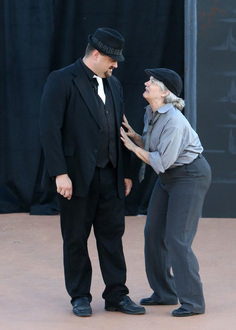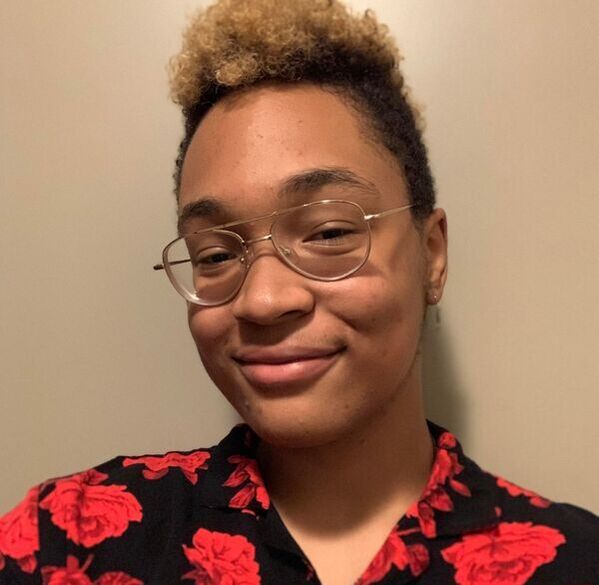 R. Andrew Aguilar as Petrucio and Sherrie Wollenhaupt as Grumio in The Taming of The Shrew 2015 Dir. Julia Nelson
R. Andrew Aguilar as Petrucio and Sherrie Wollenhaupt as Grumio in The Taming of The Shrew 2015 Dir. Julia Nelson It's not all bad news, though. Here at Bare Bones Shakespeare, we like to look at both modern and early-modern performance techniques for inspiration. 400 years ago, casting men to play women's roles was the norm in England. And several modern companies have tried reverse-gender, gender-blind, and re-gendered casting in order to achieve a variety of purposes from reconciling the cast list with the percentage of auditionees to teasing out revitalized readings of the text. These progressive casting practices aren't really prevalent yet on the largest professional stages, nor in plays written more recently, but we're gaining ground.
As a feminist I'm pleased, but as an Artistic Director, I can't stop at celebrating the forward movement. I also need to look carefully at the resistance that hinders that movement -- resistance that comes from all areas, from the local communities to the largest professional companies. Rather than dismissing this resistance out-of-hand, I think it's necessary that I seriously consider the detracting arguments (such as this article from The Guardian) and respond to them thoughtfully. In my experience, most of these arguments complain that such casting practices are merely gimmicks, or the very worst kind of Equal Opportunity Employment -- the kind that considers the race and gender of applicants as head and shoulders in importance above individual aptitude and suitability for the job. Honestly, I think this argument is correct, to a point: There have been many productions that suffered from casting the wrong actor in the name of Equality. I have personally witnessed and been involved in several productions that responded to gender half-heartedly by casting actresses instead of actors for some or all of the roles, but treated the actresses' characters inconsistently, resulting in a muddy, confusing production.
However, not all productions that resist gender norms do so at the expense of artistic clarity. The reasons for casting more actresses can be separate from how we use those actresses in performance. When I was in grad school for Shakespeare and Performance, I joined a company-model MFA program at Mary Baldwin College. Due to the accident of who auditioned and was accepted that year, our company consisted of eleven women and one man. Rather than conceding this fact as a weakness, or ignoring it and hoping no one noticed, we embraced it as a strength. We decided to treat gender differently in each of our five plays: regendering in Dr. Faustus, full drag in Fuente Ovejuna, and an all-female production of Richard II, just to name a few. From the other artists I worked with that year, I discovered that the ways to treat gender in performance are not limited to a small number of choices. I also learned that each production can have its own internal logic about how to treat gender, and that the more clear the directors and designers are early in the process on what that logic is, the clearer the production, and the stronger the acceptance of the audience.
I tested these ideas in the production of The Taming of The Shrew I directed this summer. While I didn't initially set out to create non-traditional casting choices for this production, I found myself needing to since not enough male actors auditioned, but we had more than enough female actors. I decided to re-gender three characters: Baptista, Vincentio (Vincentia) and the Pedant. However, there were also some characters, like Tranio, whose apparent maleness was central to the plot. My production team and I decided to treat the female actors in lower-class male roles as women who chose to live their lives as men for their own safety and financial security. The world of the play supported the decision to present upper-class characters such as Baptista and Vincentia as female, since these privileged women would have more power in their communities and thus could live their lives as cis-gendered without facing the same dangers as lower-class women. This logic guided decisions that we made in production meetings and in rehearsal. It was not something that we published in the program, nor did we try to force these gender politics into a more central role in the show's concept. We simply examined our extant approach to the play and added this element to it, so that our approach to gender complimented but did not dominate our approach to the text as a whole.
Now Bare Bones Shakespeare gets to try a different approach, one that is new to us. We have decided to make our upcoming production of Macbeth entirely reverse-gender. Rather than change the pronouns or put the actors and actresses in drag, though, we thought we would simply switch which roles we cast men and women into, and then use this environment to explore what the text says to our actors and our audiences about relationships within and across gender lines. If you're interested, you can watch a video of the Macbeths discussing Duncan's Murder or check out audition information.



 RSS Feed
RSS Feed